Most Popular
-
Vibration Analysis: The Key to Predictive Maintenance
Predictive maintenance offers a powerful toolbox, and vibration analysis is a cornerstone. It excels.. -
See it Before it Breaks: Non-Destructive Testing for Predictive Maintenance
Non-Destructive Testing (NDT) helps factories see inside machines to find hidden flaws, preventing c.. -
Beyond the Basics: Advanced NDT Techniques for Cutting-Edge Predictive Maintenance
This article explores cutting-edge NDT techniques like infrared thermography and acoustic emission t.. -
Don't Wait for Disaster: How Oil Analysis Saves You Money and Equipment?
Oil analysis is a preventive maintenance technique that analyzes oil to predict machine problems and.. -
From Reactive to Proactive: Oil Analysis - Your Weapon Against Downtime
Oil analysis is a powerful tool for the oil & gas industry. By analyzing lubricating oil, companies .. -
From Breakdown to Breakthrough: How NDT Minimizes Downtime and Maximizes Profits
Predictive maintenance uses NDT (Non-Destructive Testing) to inspect equipment for hidden issues, pr..
Wind energy is a rapidly growing source of clean, renewable power. However, keeping wind turbines operational and generating electricity requires a robust maintenance strategy. Unplanned downtime due to equipment failure can be costly, not only in terms of lost energy production but also in repairs and lost revenue.
This is where vibration analysis comes in as a vital tool for predictive maintenance in the wind energy industry. By monitoring the vibrations of critical components within a wind turbine, technicians can identify potential problems early on, before they escalate into major failures.
How does Vibration Analysis work in Wind Turbines?
Wind turbines are complex machines with numerous rotating parts, including the gearbox, main shaft, and generator. As these components wear or become misaligned, the resulting vibrations change in characteristic ways. Vibration sensors strategically placed on the turbine housing pick up these subtle changes.
The collected vibration data is then analyzed using specialized software. This software compares the data to established baselines and identifies any deviations that might indicate developing issues. For example, increased vibration at specific frequencies could point to bearing wear, gear misalignment, or imbalances in the blades.
Benefits of Vibration Analysis for Wind Turbines
- Reduced Downtime: By detecting problems early, vibration analysis allows for proactive maintenance scheduling, minimizing unplanned downtime and lost energy production.
- Improved Maintenance Efficiency: Vibration analysis helps pinpoint the root cause of issues, allowing for targeted repairs and reducing troubleshooting time.
- Extended Turbine Life: Early detection of problems allows for corrective actions to be taken before they cause significant damage, extending the lifespan of the turbine.
- Enhanced Safety: By identifying potential component failures before they occur, vibration analysis helps to prevent catastrophic events and improve overall safety for personnel working on wind turbines.
Examples of Applications
- Gearbox Monitoring: Gearboxes are critical components in wind turbines, and their failure can be extremely expensive. Vibration analysis helps detect gear wear, misalignment, and pitting before they lead to a complete gearbox breakdown.
- Bearing Fault Detection: Bearings are another critical component susceptible to wear and fatigue. Vibration analysis can identify different types of bearing faults, allowing for timely maintenance and preventing catastrophic failures.
- Blade Imbalance: Wind turbine blades are subjected to significant wind loads. Vibration analysis can detect imbalances in the blades, which can lead to increased stress on the turbine structure and reduced efficiency.
Vibration analysis plays a crucial role in keeping wind turbines operational and maximizing energy production. By proactively identifying and addressing potential problems, wind energy companies can ensure the smooth operation of their turbines, reduce costs, and contribute to a more reliable and sustainable energy future.
Connect with Arrelic Global to discuss your vibration analysis needs!
